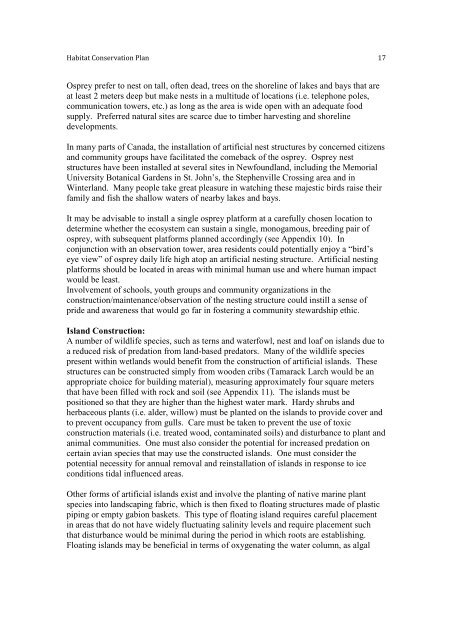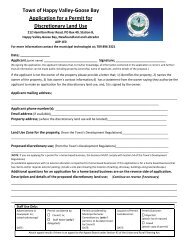Habitat Conservation Plan Habitat Conservation Plan for the Town ...
Habitat Conservation Plan Habitat Conservation Plan for the Town ...
Habitat Conservation Plan Habitat Conservation Plan for the Town ...
- No tags were found...
Create successful ePaper yourself
Turn your PDF publications into a flip-book with our unique Google optimized e-Paper software.
<strong>Habitat</strong> <strong>Conservation</strong> <strong>Plan</strong> 17Osprey prefer to nest on tall, often dead, trees on <strong>the</strong> shoreline of lakes and bays that areat least 2 meters deep but make nests in a multitude of locations (i.e. telephone poles,communication towers, etc.) as long as <strong>the</strong> area is wide open with an adequate foodsupply. Preferred natural sites are scarce due to timber harvesting and shorelinedevelopments.In many parts of Canada, <strong>the</strong> installation of artificial nest structures by concerned citizensand community groups have facilitated <strong>the</strong> comeback of <strong>the</strong> osprey. Osprey neststructures have been installed at several sites in Newfoundland, including <strong>the</strong> MemorialUniversity Botanical Gardens in St. John’s, <strong>the</strong> Stephenville Crossing area and inWinterland. Many people take great pleasure in watching <strong>the</strong>se majestic birds raise <strong>the</strong>irfamily and fish <strong>the</strong> shallow waters of nearby lakes and bays.It may be advisable to install a single osprey plat<strong>for</strong>m at a carefully chosen location todetermine whe<strong>the</strong>r <strong>the</strong> ecosystem can sustain a single, monogamous, breeding pair ofosprey, with subsequent plat<strong>for</strong>ms planned accordingly (see Appendix 10). Inconjunction with an observation tower, area residents could potentially enjoy a “bird’seye view” of osprey daily life high atop an artificial nesting structure. Artificial nestingplat<strong>for</strong>ms should be located in areas with minimal human use and where human impactwould be least.Involvement of schools, youth groups and community organizations in <strong>the</strong>construction/maintenance/observation of <strong>the</strong> nesting structure could instill a sense ofpride and awareness that would go far in fostering a community stewardship ethic.Island Construction:A number of wildlife species, such as terns and waterfowl, nest and loaf on islands due toa reduced risk of predation from land-based predators. Many of <strong>the</strong> wildlife speciespresent within wetlands would benefit from <strong>the</strong> construction of artificial islands. Thesestructures can be constructed simply from wooden cribs (Tamarack Larch would be anappropriate choice <strong>for</strong> building material), measuring approximately four square metersthat have been filled with rock and soil (see Appendix 11). The islands must bepositioned so that <strong>the</strong>y are higher than <strong>the</strong> highest water mark. Hardy shrubs andherbaceous plants (i.e. alder, willow) must be planted on <strong>the</strong> islands to provide cover andto prevent occupancy from gulls. Care must be taken to prevent <strong>the</strong> use of toxicconstruction materials (i.e. treated wood, contaminated soils) and disturbance to plant andanimal communities. One must also consider <strong>the</strong> potential <strong>for</strong> increased predation oncertain avian species that may use <strong>the</strong> constructed islands. One must consider <strong>the</strong>potential necessity <strong>for</strong> annual removal and reinstallation of islands in response to iceconditions tidal influenced areas.O<strong>the</strong>r <strong>for</strong>ms of artificial islands exist and involve <strong>the</strong> planting of native marine plantspecies into landscaping fabric, which is <strong>the</strong>n fixed to floating structures made of plasticpiping or empty gabion baskets. This type of floating island requires careful placementin areas that do not have widely fluctuating salinity levels and require placement suchthat disturbance would be minimal during <strong>the</strong> period in which roots are establishing.Floating islands may be beneficial in terms of oxygenating <strong>the</strong> water column, as algal






